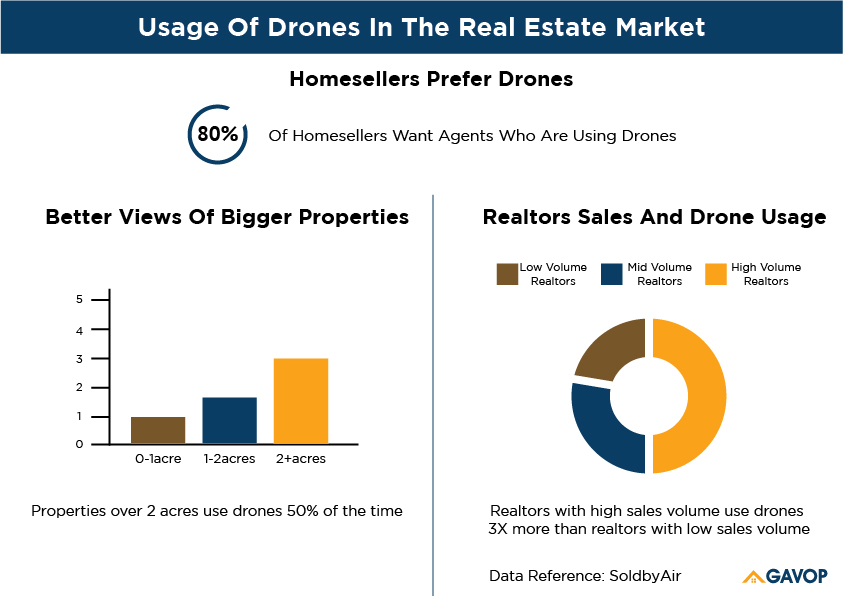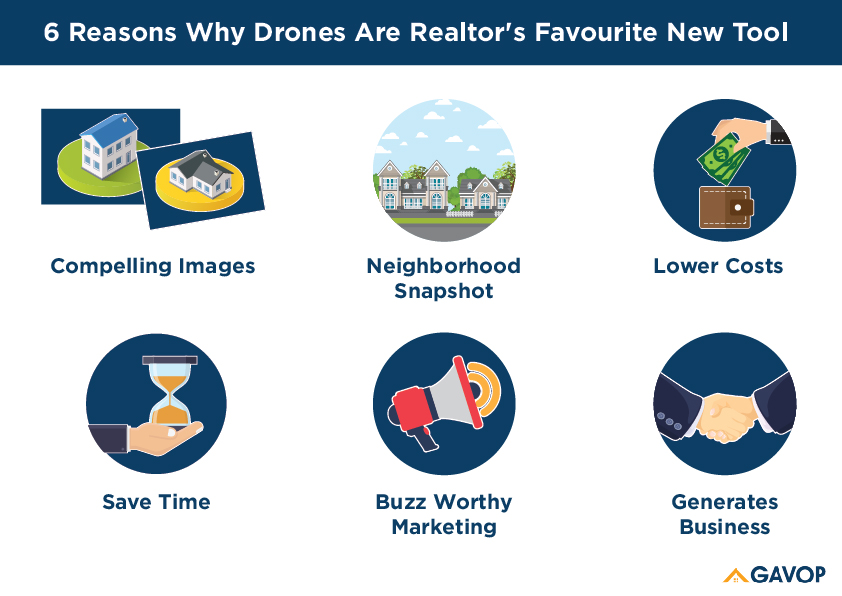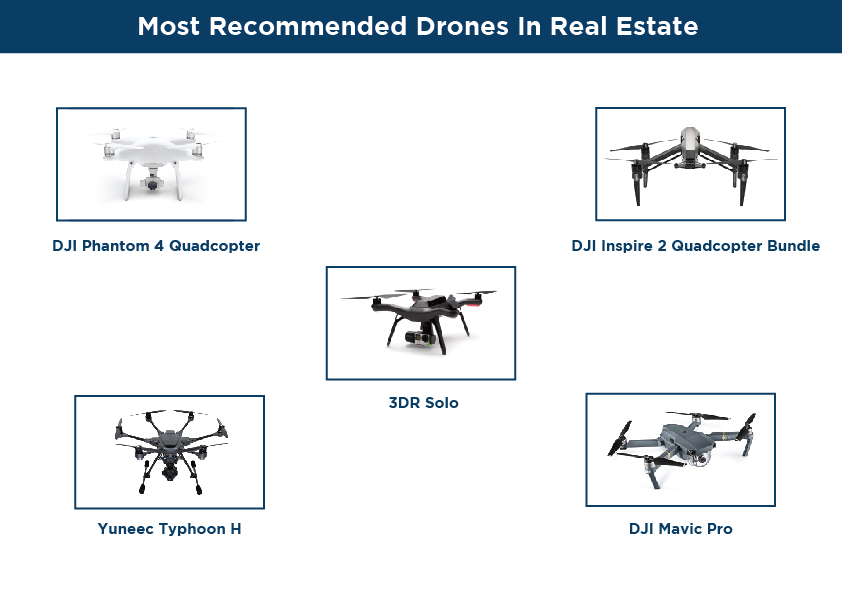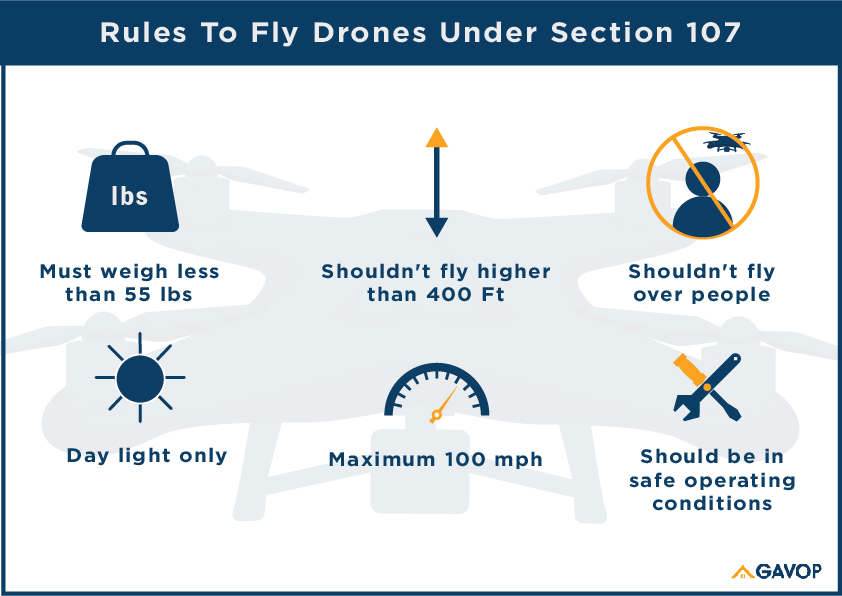Drones for Real Estate: The Benefits, Guidelines and Top Drones
By: Shravya Reddy May.8, 2019
Drone technology is one of the most important innovations in real estate marketing and listings. Low-quality images and grainy satellite aerial shots no longer make the cut. In the United States alone, 60% of new property buyers favor images shot by a drone, and 73% of real estate clients prefer to add videos shot by drones in their listing. A well-made aerial video can serve as a virtual tour for a potential new home.
Benefits of Using Drones In The Real Estate Market
Given the extremely competitive nature of the real estate market and the reasonable cost of using drones for photography, most professionals in the field, believe, soon, the use of drone technology will become indispensable to a property listing campaign. Not only does it show the buyer how invested and committed the realtor/seller is, but it also gives visual insight on previously hard-to-access vantage points such as high decks, waterfront views, and other such features part of the property. And so it comes as no surprise that 80% of home sellers also prefer realtors who use drone technology.

Using data from Meero and Soldbyair, Gavop found that properties listed with drones’ aerial view sell at a higher rate as compared to traditional 2D photography since modern home buyers’ preferences have changed significantly. This study also found that realtors with a high volume of sales used drones almost three times more than realtors with a low sales volume in their real estate marketing. Also, 50% of high dollar volume transactions and large properties are shown better through drone images and media. From producing compelling images and videos to creating buzzworthy listings, drones have become integral to most real estate marketing campaigns.
Compelling Images: One can get a comprehensive view of the interior & exterior of the property with the use of drones. Gone are the days of low-quality photos and a limited view of ground shots of the property. With this new technology, drones can capture high-quality images with a wide array of camera angles and vantage points, that were once previously impossible to shoot, to help provide clients with an accurate representation of the property and the neighborhood.
Buzz Worthy Marketing: Drones are still relatively new as a marketing tool and considered trendy in the real estate sector. Having them can raise a realtor's listing profile. Given the innovative mechanism behind this method of marketing, it comes as no surprise that potential clients instantly appreciate and are drawn to this kind of marketing, as compared to the old school industry standard of 2D images.
Lower Costs: Previously, one would have to use helicopters or low-resolution satellite images for aerial shots of a property. Today, it is a lot easier to capture high-quality images in a fraction of the cost, thanks to the availability of drones. A one minute video shot by a hired drone operator should set you back by $200-$400 depending on your requirement.
Save Time: Drone images and videos give you a virtual tour of the entire property, the neighborhood and other attractions nearby, that one can only access during in-person site visits. Now thanks to drone technology, one can see all the specifications right at the click of a button, saving the potential homebuyer time, especially, if it is a property they would like to skip.
Neighborhood Snapshot: Not limited to just property listings, homebuyers, especially new transferees, can now use this tool to get a snapshot of a new town or area they might be moving in to. From nearby parks, shopping centers, community centers and more, they can get a far more extensive picture of a neighborhood by looking at drone images and videos than just a basic internet image search on the same.
Generates Business: According to Multiple Listing Service (MLS) statistics, properties that have images shot using drone technology are 70% more likely to sell than those without. And this trend is gaining more traction largely because of increased accessibility and positive client response to the same. This has shown an increase in sales and a definite boost for realtors aiming to clear out their inventory faster.

Drones Are Here To Stay
Numbers never lie. According to TechHelpline, 10 million drones were sold last year and that number is expected to triple in the next 3 years. Realtors and homebuyers are now more than ever determined to get a bang for their buck. With a surge in technological advancements in real estate marketing, world-over, the drone industry valuation is expected to be $90 billion by 2025 and is used mostly in real estate than any other market in North America. There are a plethora of drone models in the market depending on your requirements and budget. Gavop rounded out some of the most recommended and popular drone models used for real estate in the market today.
1. DJI Phantom 4 Quadcopter: Is Favoured by most as the best overall drone used for real estate purposes. This model is particularly known for having a wide assortment of features including 720p HD transmission with a range of up to 3.1 miles. Price: $1000 | Flight time: 28min
2. DJI Inspire 2 Quadcopter Bundle: Prices on the higher side, this model allows you to combine the drone with the X4S or the X5S gimbal cameras for better imaging. Price $3000 | Flight time: 27min
3. Yuneec Typhoon H: One of the best value-for-money options available in the market today, the Yuneec Typhoon H has a 360 degree unobstructed camera along with collision avoidance technology. Price: $999 | Flight time: 20min
4. 3DR Solo: For those on a tight budget, the 3DR Solo is equipped with an intelligent flight computer and is GoPro compatible. Price: $499 | Flight time: 30min
5. DJI Mavic Pro: The Mavic Pro is considered to be one of the best in its class of models. Built with 100% foldable arms, which helps render the drone into the size of a water bottle, is a huge plus for portability. Price: $765 | Flight time: 27min

FAA Guidelines For Drones Used In Real Estate
Considering the competition in the real estate market, in order to stand out, realtors have to be tech-savvy as well as use new technology to capture the complete view of a building. However, the Federal Aviation Administration (FAA) issued a set of guidelines and regulations for use of drones that weigh less than 55 pounds. The pilot must be 16 years of age or older to operate a drone for commercial purposes. Whether you are outsourcing the work or doing it yourself, you must comply to Part 107 guidelines of FAA regulations, issued in 2016. Some of the key guidelines have been illustrated in the infographic below.

- FAA Registration: A drone larger than 0.5 lbs in weight requires FAA registration
- Maximum Altitude: Drone pilots must follow FAA guidelines, which include flying no higher than 400 ft
- Safe Operating Conditions: The pilot must complete a pre-flight checklist and inspection of the drone to ensure it is in good condition to ensure safe flying
- Speed Limit: Maximum permissible groundspeed is 100 mph (87 knots)
- Maintain VLOS: The unmanned aircraft must remain within visual line-of-sight (VLOS) of the remote pilot in command
- Restricted Air Space: No drone is allowed to be flown with a 5 mile radius of an airport
- Day-Light Only: Daylight-only operations, or civil twilight (30 minutes before official sunrise to 30 minutes after official sunset, local time) witt appropriate anti-collision lighting
- Minimum Age: The pilot must be 16 years of age or older to operate a drone for commercial purposes
- UAV operator’s certificate: Whether you are paid or not, anybody flying a drone for commercial purposes including real estate, requires an FAA issued drone/UAV operator's certificate
- Flying Over People: Drones may not be operated over people without their written permission unless they are located under a covered structure or inside a stationary vehicle that would provide reasonable protection in the event of an accident
- Weather Conditions: Minimum weather visibility of 3 miles from a control station
- Drone Insurance: It is recommended that every drone operator have suitable drone insurance in case of damage or injury
ABOUT THE AUTHOR

Shravya Reddy
Shravya Reddy is a writer, public relations associate and content producer. She has worked in the corporate space on various mediums of print media as well as digital media. As a journalist, she has covered a range of topics including real estate, architecture, design, and technology. She has contributed to various online publications as a copywriter and copy editor. Shravya has done her BA in Journalism, Film & Media from Cardiff University. In her spare time, she enjoys traveling, exploring new cuisines and culture and wildlife.